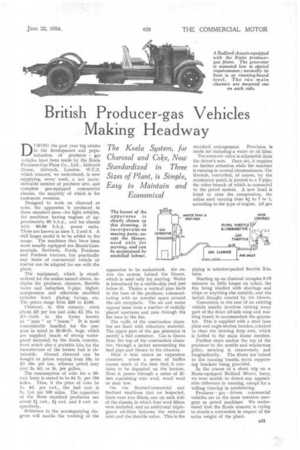British Producer-gas Vehicles Making Headway
Page 45

If you've noticed an error in this article please click here to report it so we can fix it.
The Koela System, for Charcoal and Coke, Now Standardized in Three Sizes of Plant, is Simple, Easy to Maintain and Economical
DTIRING the past year big strides in the development and popu
larization of producer gas vehicles have been made by the Koela Producer-Gas Plant Co., Ltd., Aldwych house, Aldwych, London, W.C.2, which concern, we understand, is now supplying, every week, a not inconsiderable number of producer sets, and complete gas-equipped commercial chassis, the majority of which is for customers overseas.
Designed to work on charcoal or coke, the apparatus is produced in three standard sizes---for light vehicles, for machines having engines of approximately 60 b.h.p., and for chassis with 80-90 b.h.p. power units. These are known as sizes 1, 2 and 3. A still larger model is to be added to the range. The machines that have been most usually equipped are Morris-Commercials, Bedfords, Fords, Fordsons and Fordson tractors, but practically any make of commercial vehicle or tractor can be adapted for use with the plant.
The equipment, which is standardized for the makes named above, includes the producer, cleaners, throttle valve and induction T-pipe, highercompression and otherwise modified cylinder head, piping, fixings, etc. The prices range from 250 to 2100.
Charcoal, in this country, costs about 28 per ton and coke .2,1 10s. to 2:1—both in the forms known as " peas " or " beans." It is most conveniently handled for the purpose in mind in 25-30-lb. bags, which are supplied (made of strong waterproof material) by the Koela concern, frons which also a portable kiln for the manufacture of the former fuel is obtainable. Abroad charcoal can be bought at prices varying from 10s. to 21 10s. per ton, whereas petrol may cost 2s. 6d. or 3s. per gallon.
The consumption of coke for a SOcwt. lorry is stated to be 84 lb. per 100 miles. Thus, if the price of coke be Is. 6d. per cwt., the fuel cost is 1s. lid, per 100 miles. The capacities of the three standard producers are about 21 cwt., si cwt. and 5 cwt. respectively.
Reference to the accompanying diagram will enable the working of the apparatus to be understood. Air enters the system behind the blower, which is used only for starting. Water is introduced by a visible-drip feed just below it. Thence a vertical pipe leads to the base of the producer, communicating with an annular space around the ash receptacle. The air and water vapour issue from a number of radially placed apertures and pass through the fire bars to the fire.
The walls of the combustion chamber are lined with refractory material. The upper part of the gas generator is merely a fuel container. Gas is drawn from the top of the combustion chamber, through a jacket surrounding the feed pipe and thence to the cleaners.
Here it first enters an expansion chamber, where a series of baffles causes much of the dust that it contains to be deposited on the bottom. Next it passes through a series of filters containing wire wool, wood wool or sisal tow.
On the Morris-Commercial and Bedford machines that we inspected, there were two filters, one on each side of the chassis, in which four wool filters were included, and an additional tripleganye oil-filter between the extra-air inlet and the throttle valve. This is the standard arrangement, Provision is made for including a water or oil filter.
The extra-air valve is adjustable from the driver's seat. Once set, it requires no further attention while the machine is running in normal circumstances. The throttle, controlled, of course, by the accelerator pedal, is jointed to a T-pipe, the other branch of which is connected to the petrol system. A new head is fitted to raise the compression, the ratios used varying from 61 to 7 to 1, according to the type of engine. All gas piping is asbestos-packed flexible 2-in. tube. • Starting up on charcoal occupies 5-10 minutes (a little longer on coke), the fire being kindled with shavings and chips or anything else suitable, and the initial draught created by the blower.
Conversion in the case of an existing vehicle usually involves cutting away part of the front off-side wing and running board, to accommodate the generator. This is supplied with a steel base plate and angle-section bracket, cranked to clear the steering drop arm, which is bolted to the main frame member.
Further stays anchor the top of the producer to the scuttle and windscreen pillar, securing it transversely and longitudinally. The filters are bolted to the running boards, extra supporting brackets being provided.
In the course of a short trip on a Koela-equipped Bedford 30-cwt. lorry, we were unable to detect any appreciable difference in running, except for a trifling time-lag in accelerating.
Producer gas driven commercial vehicles are in the same taxation category as petrol machines. We understand that the Koela concern is trying to obtain a concession in respect of the extra weight of the plant. .




























































































